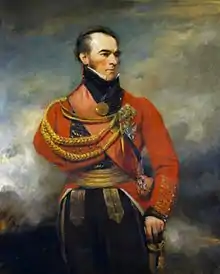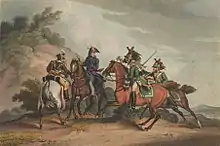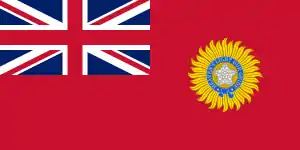Edward Paget
General Sir Edward Paget GCB (3 November 1775 – 13 May 1849) was a British Army officer.
Sir Edward Paget | |
|---|---|
 | |
| 4th Governor of British Ceylon | |
| Monarch | George IV |
| Preceded by | Edward Barnes (Acting governor) |
| Succeeded by | James Campbell (Acting governor) |
| Personal details | |
| Born | 3 November 1775 |
| Died | 13 May 1849 (aged 73) |
| Awards | Knight Grand Cross of the Order of the Bath |
| Military service | |
| Allegiance | United Kingdom |
| Branch/service | British Army |
| Rank | General |
| Battles/wars | Peninsular War |
Career
Born the fourth son of Henry Paget, 1st Earl of Uxbridge, Edward Paget became a cornet in the 1st Regiment of Life Guards in 1792.[1] He was Member of Parliament (MP) for Caernarvon Boroughs from 1796 to 1806.
In 1808, he was with John Moore in Gothenburg assist the Swedish in the Finnish War. Moore's disagreements with Gustavus IV soon led to their being sent home where they were ordered to Portugal.

He served in the British Army during the Peninsular War commanding the reserve at the Battle of Corunna in 1809 and then conducting the advance to Oporto in 1809, during which he lost his right arm.[2] He was second in command under Arthur Wellesley, 1st Duke of Wellington in 1811[2] and was captured by French cavalry in 1812 and kept a prisoner for two years until the end of the War.[3]
From 1816 to 1821 he was a Groom of the Bedchamber in the service of George IV, including a period 1816-1820 when the latter was Prince Regent during the mental illness of his father, George III.
Briefly serving as the Governor of Ceylon in 1822, he was appointed Commander-in-Chief, India on 13 January 1823 and conducted the Burmese campaigns of 1824 to 1825,[2] relinquishing his role of as Commander-in-Chief on 7 October 1825. He commanded the British troops who suppressed the Barrackpore mutiny of 1824. In 1826 he was appointed Governor of the Royal Military College, Sandhurst.[1] He was also Governor of the Royal Hospital Chelsea from 1837 until 1849.[2]
His eldest brother Henry William, 2nd Earl of Uxbridge (1768–1854), was in 1815 created Marquess of Anglesey and is best remembered for leading the charge of the heavy cavalry at the Battle of Waterloo. The third eldest brother, Sir Arthur Paget (1771–1840), was an eminent diplomat during the Napoleonic wars, the fifth, Sir Charles Paget (1778–1839),[4] served with distinction in the navy, and rose to the rank of vice-admiral.
Legacy
The Memorials to Governors in the Chapel of the Royal Military Academy, Sandhurst includes:
In Memory of General the Honble. Sir Edward Paget, G.C.B., Colonel 28th Foot. Died 13th May, 1849, aged 73 years. His war services are as follows: —Holland, Nimeguen, Gueldermalsen, 1794-5; Cape St. Vincent, 1797 Minorca, 1798 ; Egypt, three actions, wounded, 1801 ; Bremen, 1805 ; Sicily, 1806-7 ; Sweden and Portugal, 1808 ; Corunna and Passage of the Douro, lost right arm, 1809; Second-in-Command to Wellington, Retreat from Burgos, taken prisoner, 1812. Commander-in-Chief in India, 1822-25. Governor of this College, 1826-37. Afterwards Governor of Chelsea Hospital.[5]
References
- . Dictionary of National Biography. London: Smith, Elder & Co. 1885–1900.
- H. Godfrey, ed. (1927), Survey of London, 11, pp. 37–60
- Edwin Bartlett on the capture of Paget and the politics of America, Britain and the Iberian Peninsula Archived 25 December 2008 at the Wayback Machine Retrieved 24 August 2017.
- Burkes Peerage (1939 edition, s.v. Anglesey, Marquess of
- Major Augustus F. Mockler-Ferryman F.R.G.S., F.Z.S. `Annals of Sandhurst : a chronicle of the Royal Military College from its foundation to the present day, with a sketch of the history of the Staff College` (London: William Heinemann, 1900)
| Parliament of Great Britain | ||
|---|---|---|
| Preceded by Lord Paget |
Member of Parliament for Caernarvon Boroughs 1796–1800 |
Succeeded by Parliament of the United Kingdom |
| Parliament of the United Kingdom | ||
| Preceded by Parliament of Great Britain |
Member of Parliament for Caernarvon Boroughs 1801–1806 |
Succeeded by Sir Charles Paget |
| Government offices | ||
| Preceded by Edward Barnes acting governor |
Governor of Ceylon 1822 |
Succeeded by James Campbell acting governor |
| Military offices | ||
| Preceded by The Marquess of Hastings |
Commander-in-Chief, India 1823–1825 |
Succeeded by The Viscount Combermere |
| Preceded by Sir George Murray |
Governor of the Royal Military College Sandhurst 1826–1837 |
Succeeded by Sir George Scovell |
| Honorary titles | ||
| Preceded by Sir Samuel Hulse |
Governor, Royal Hospital Chelsea 1837–1849 |
Succeeded by Sir George Anson |
.svg.png.webp)
